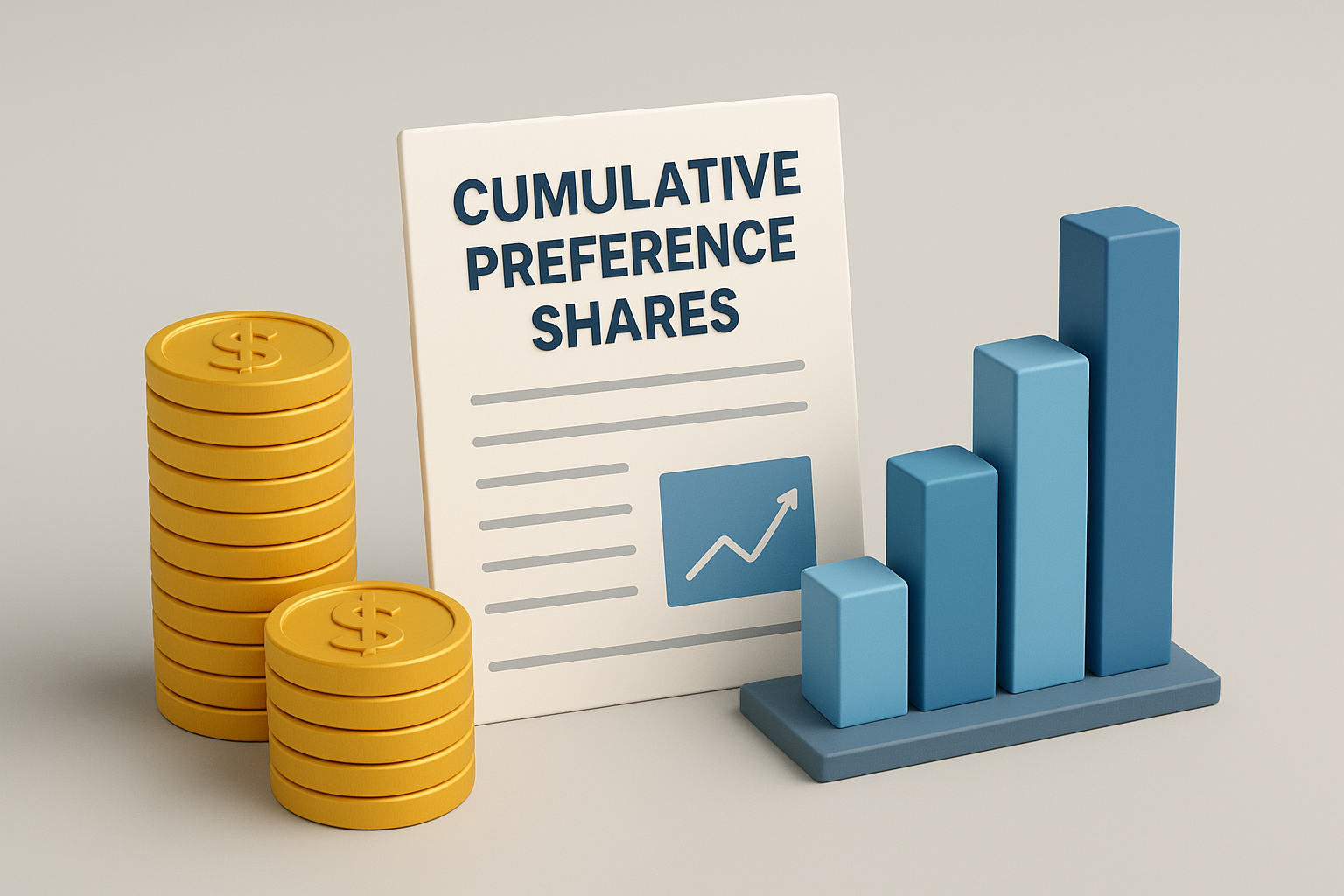Cumulative Preference Shares - Meaning, Difference & Advantages

- Published Date: October 24, 2025
- Updated Date: November 21, 2025
- By Team Choice
In the world of finance and investment, stocks come in different forms, each with unique benefits and risks. Among these, preference shares are a popular choice for investors seeking regular income with relatively lower risk compared to equity shares. A specific type of preference share, known as cumulative preference shares, offers additional protection for investors in terms of dividend payments.
In this blog, we’ll break down the cumulative preference shares meaning, its features, advantages, and differences from other shares is essential for making informed investment decisions.
What Is Cumulative Preference Shares?
Cumulative preference shares carry all the typical features of regular preference shares, such as priority in dividend payments, entitlement to higher dividends than equity shareholders, and preference during the company’s liquidation process.
What sets cumulative preference shares apart is their unique advantage: shareholders are entitled to receive dividends even if the company has previously been unable to distribute them.
At times, a company may face financial constraints and may either skip dividend payments or pay only a portion of the intended dividends. In such situations, cumulative preference shareholders retain the right to claim any unpaid dividends in the future, unlike equity shareholders, who may lose out on missed dividends.
How Cumulative Preference Shares Work?
Cumulative preference shares function on the principle of priority over equity shares for dividend payments. Here’s how they work:
- Fixed Dividend Rate: Cumulative preference shareholders receive a predetermined dividend, usually expressed as a percentage of the face value of the share.
- Accumulation of Dividends: If a dividend is not paid in a particular year, it is added to the unpaid dividend pool.
- Payment Priority: The company must pay all accumulated dividends to cumulative preference shareholders before paying any dividends to equity shareholders.
- Redemption: These shares can be redeemed by the company at a later date, often at face value plus any accumulated dividends.
This mechanism ensures a steady stream of returns for investors, even in years when the company cannot distribute profits to equity shareholders.
Advantages Of Cumulative Preference Shares
Here are some of the advantages of cumulative preference shares:
- Assured Dividend Payments: Shareholders are entitled to receive dividends even if the company misses a payment in any year. Missed dividends accumulate and are paid later, ensuring income stability.
- Lower Investment Risk: Compared to equity shares, cumulative preference shares carry less risk because dividends take priority over equity shareholders and are guaranteed once profits are available.
- Attractive for Income-Focused Investors: Investors looking for steady and predictable returns often prefer cumulative preference shares due to their guaranteed dividend feature.
- Priority During Liquidation: In the event of company liquidation, cumulative preference shareholders receive their investment back before equity shareholders, offering additional financial security.
- Financial Planning: Regular and cumulative dividends make it easier for investors to plan their finances and cash flow compared to the unpredictable returns of equity shares.
Disadvantages / Limitations of Cumulative Preference Shares
While cumulative preference shares provide certain advantages, they also come with some limitations that investors should consider:
- No Voting Rights: Generally, holders of cumulative preference shares do not have the right to vote in company decisions, limiting their influence on corporate governance.
- Limited Growth Potential: These shares offer fixed dividends, so their potential for capital appreciation is much lower than equity shares, which can increase significantly in value over time.
- Dependence on Company Profits: Dividends can only be paid if the company generates sufficient profits. While unpaid dividends accumulate, there is no guarantee of immediate payment.
- Inflation Risk: Fixed dividend payments may lose purchasing power over time, particularly during periods of high inflation.
- Not Ideal for Aggressive Investors: Investors seeking high returns from market fluctuations may find cumulative preference shares less appealing due to their conservative nature.
Difference Between Cumulative and Non Cumulative Preference Shares
Understanding the difference between cumulative and non-cumulative preference shares is essential for investors looking to make informed decisions. The key differences are as follows:
| Feature | Cumulative Preference Shares | Non-Cumulative Preference Shares |
|---|---|---|
| Dividend Accumulation | Unpaid dividends are carried forward and must be paid in the future. | Unpaid dividends are not carried forward; if skipped, they are forfeited. |
| Dividend Priority | Dividends must be paid to shareholders before equity dividends, including any accumulated amounts. | Dividends are paid before equity shareholders, but missed dividends are lost permanently. |
| Risk Level | Lower risk due to the accumulation feature, ensuring eventual payment. | Higher risk since skipped dividends cannot be recovered. |
| Investor Appeal | Ideal for investors seeking steady and guaranteed income. | Suited for investors willing to accept higher risk for potential short-term gains. |
Conclusion
Cumulative preference shares offer a unique combination of income stability and risk mitigation, making them an attractive choice for conservative investors. By guaranteeing the payment of accumulated dividends before equity shareholders, these shares provide financial security and predictability. However, investors should also consider their limited growth potential and lack of voting rights before investing.
For those seeking a balance between safety and steady income, understanding the features and advantages of cumulative preference shares is essential.
FAQs
1. Are cumulative preference shares better than equity?
It depends on investment goals. Cumulative preference shares are safer and provide fixed dividends, while equity shares offer higher potential returns but come with higher risk.
2. Can dividends be skipped forever?
No. For cumulative preference shares, unpaid dividends accumulate and must be paid in the future before equity dividends.
3. Do cumulative preference shareholders have voting rights?
Typically, they do not have voting rights unless the company fails to pay dividends for an extended period, as per corporate rules.
4. What are non-cumulative preference shares?
Non-cumulative preference shares do not accumulate unpaid dividends. If a dividend is skipped in a financial year, the shareholder loses the right to receive it in the future.
Recommended for you

Covered Call Strategy Explained

FII DII Data - Live Data

Share Market Prediction For Tomorrow
